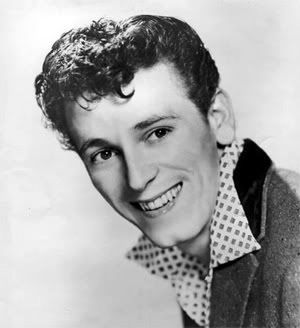
This promo photograph was used to publicize
Gene Vincent 's 1960 Escanaba show.
By STEVE SEYMOUR
When rock legend Gene Vincent, known for "Be-Bop-A-Lula," appeared in Escanaba near the end of 1960, he had been on an emotional roller coaster.
As fans filed into the William W. Oliver Auditorium on Dec. 29 to witness Vincent's fabled stage show, they were probably unaware of what the performer had gone through during the previous 12 months.
Vincent started the year with a tour of American Air Force bases, then found himself on a hugely-popular British tour titled "Anglo-American Beat Show." His good friend Eddie Cochran, the Minnesota native responsible for "Summertime Blues," shared the stage with Vincent. 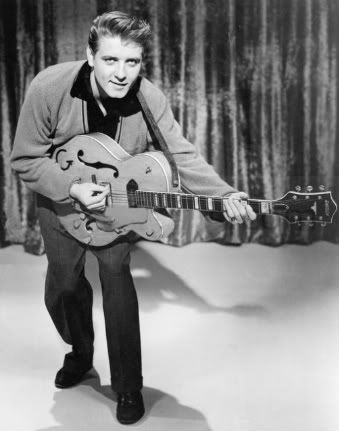
Eddie Cochran
On Jan. 12, he appeared with Cochran on the British variety show "Boy Meets Girl." The two entertainers performed at the Empire Theater in Glasgow on Feb. 1 and ended a 12-week tour of the British Isles on April 16.
But, after that final show, tragedy struck. A taxi carrying the two singers and Cochran's fiancee, Sharon Sheeley, blew a tire and struck a concrete post on the way to London airport. Vincent and Sheeley survived, but Cochran died at the hospital.
Vincent sustained a broken collarbone, fractured arm and cracked ribs. He also suffered additional injuries to his left leg, which doctors had nearly amputated following a motorcycle accident in Norfolk, Virginia, years earlier.
Born in Norfolk, Vincent was given his first guitar at age 12. Despite his interest in music, he joined the Navy in 1952.
Shortly after he re-enlisted, the Triumph motorcycle Vincent was operating was struck by a car. Doctors saved Vincent's leg, but the Navy issued him a medical discharge and orders to wear a leg brace.
With his Navy stint over, Vincent formed the Blue Caps and won a talent contest sponsored by Norfolk disc jockey Bill "Sheriff Tex" Davis, who was soon managing the group.
By the summer of 1956, Vincent had written "Be-Bop-A-Lula" with Davis and watched it become a number seven hit for Capitol Records. The song charted for 20 weeks and launched Vincent's career in rock 'n' roll and rockabilly.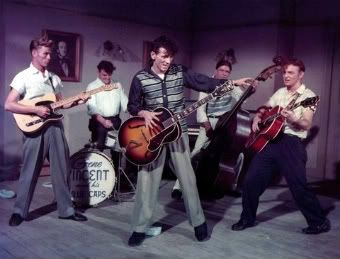
Vincent performed "Be-Bop-A-Lula" in the film "The Girl Can't Help It."
The singer-songwriter-guitarist burnished his reputation with an appearance in four motion pictures, including "The Girl Can't Help It," starring Jayne Mansfield. Dressed in black leather and blue denim, Vincent's biker look in the film was widely copied.
Gene Vincent and His Blue Caps enjoyed another hit in 1957, when "Lotta Lovin'" went to number 13. "Dance to the Bop" followed.
Vincent's reputation grew when he appeared on television programs hosted by Ed Sullivan, Dick Clark and Steve Allen.
By 1959, the Capitol Records recording artist had discovered audiences in England, France, Japan and Australia eager to see his raucous stage show.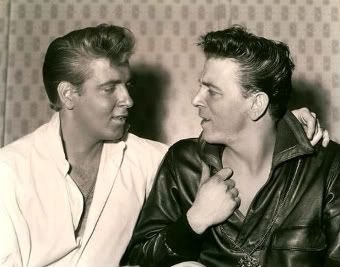
Eddie and Gene
Those shows were twice as exciting when Vincent teamed up with Cochran, another talented guitarist and dynamic live performer. When the calamitous road mishap claimed Cochran, his single at the time was "Three Steps to Heaven," which topped the charts in the United Kingdom.
Although he sent flowers for Cochran's funeral service, Vincent was too devastated to attend. He was discharged from the hospital on April 19 and returned to the United States the next day.
Still, Vincent returned to London and was back on tour on April 30. He booked time at Abbey Road Studio on May 11 to record "Pistol Packing Mama" and "Weeping Willow." The single reached number 15 in the UK.
Vincent's sixth long-playing record, "Crazy Times," was also released during the year. His wife Darlene gave birth to a son, Gene Vincent, Jr., although fans were still being told Vincent was single.
In the early 1960s, Vincent toured the upper Midwest, playing shows for $300 a night.
Now, the Upper Peninsula was calling. Vincent, then 25, agreed to appear in concert at the Junior High auditorium for two shows on Thursday, Dec. 29, 1960. The events were sponsored by the Escanaba Band Boosters and Escanaba High School Fan Club, with proceeds being used to buy new band uniforms.
Admission to the matinee was 60 cents, while entry to the evening show cost $1. Tickets were sold at Delta Music Center, Gust Asp's and Advanced Electric Co. Advanced stocked Vincent's albums and the High Lights' single for interested customers.
A newspaper advertisement promised Vincent's show would be the "greatest Rock and Roll jamboree ever presented in our town." It urged readers to "fall in and make this scene, it's the absolute end." The notice promised the star would "rock it up in person."
Vincent did not appear with his Blue Caps as fans may have expected, but instead performed with members of the High Lights, a combo from Austin, Minnesota. Led by drummer Al Anderson, the group also included Gary Bailey, Bob Bulger, Dale Olsen and Barry Rush. They were known for their recording, "Ah So," an instrumental released on Play Records.
Certainly, Vincent played "Be-Bop-A-Lula" during his Escanaba shows, but the remainder of those long-ago setlists might never be known.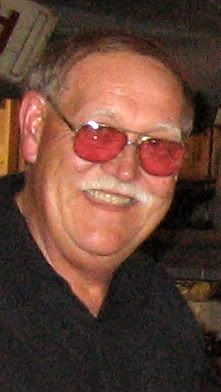
Bob Hanson
Although guitarist Bob Hanson did not play with Vincent during the Escanaba show, he did perform with him at a gig in Iron Mountain. "I remember it was about 20 below zero and we didn't have much of a crowd," Hanson told me.
Vincent played "Baby Blue," "Be-Bop-A-Lula" and "Bluejean Bop," Hanson recalled. The audience also heard Vincent perform "Corrina, Corrina" and many other songs.
"He had a marvelous voice," Hanson added.
"You had to be crazy and do crazy things on stage with him that no other band would do in those days. We had a lot of fun working with him."
Piano player Roger Johnson relates another story when Vincent had to travel overnight from Hancock to a Canadian show. Vincent had recently returned from England and Cochran's death was probably still on his mind.
"It had been snowing heavily and I drove the road manager's car, with Gene in the passenger seat. The poor man was scared to death all night long, while the road manager slept in the back seat, oblivious to everything," Johnson recalled.
Vincent never regained the momentum he enjoyed before Cochran's untimely death.
The hectic life of a touring musician took a toll on Vincent, who continued to suffer chronic leg pain throughout his life. Wedded bliss escaped him as he was married and divorced four times. Mood swings and bouts of drinking disrupted his life.
The end came on Oct. 12, 1971 when Vincent ruptured a stomach ulcer in a fall at his parents' house in Newhall, California and died an hour later. He was 36 years old.
"When people find out I worked with Gene, they all want to hear his music which I know inside out," said guitarist Hanson, who still performs a few nights a week in Florida. "I can assure you he was one of the nice guys in show business and died at a much too early age. At one time, he was as big a star as Elvis."

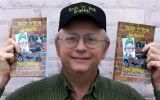
 I've enjoyed rock music and writing since I was a teenager in the 60s. I feel lucky to have been around when rock's greatest stars created their most enduring hits. At the same time I found I enjoyed writing, as well. I worked on my high school newspaper and magazine, was editor of several college publications and earned a bachelor's degree from Central Michigan University in 1973. I worked for the daily newspaper in my hometown after graduating, becoming managing editor after a few years. By the 1980s, I moved into public relations. In 1985, my wife Sue and I opened a retail music store, The Record Rack, which we still own. Rock 'n' roll has been integral to me and for the last 2O years I've been earning my living from it even though I don't have a musical bone in my body. In recent years, I've also I edited a small local magazine and launched a micro FM radio station. Now, I'm finally combining my love of writing and rock 'n' roll. I can't sing a note, but I know what I like. I'll tell you all about it when you read on. I hope you have as much enjoyment reading these installments as I've had writing them.
I've enjoyed rock music and writing since I was a teenager in the 60s. I feel lucky to have been around when rock's greatest stars created their most enduring hits. At the same time I found I enjoyed writing, as well. I worked on my high school newspaper and magazine, was editor of several college publications and earned a bachelor's degree from Central Michigan University in 1973. I worked for the daily newspaper in my hometown after graduating, becoming managing editor after a few years. By the 1980s, I moved into public relations. In 1985, my wife Sue and I opened a retail music store, The Record Rack, which we still own. Rock 'n' roll has been integral to me and for the last 2O years I've been earning my living from it even though I don't have a musical bone in my body. In recent years, I've also I edited a small local magazine and launched a micro FM radio station. Now, I'm finally combining my love of writing and rock 'n' roll. I can't sing a note, but I know what I like. I'll tell you all about it when you read on. I hope you have as much enjoyment reading these installments as I've had writing them.


No comments:
Post a Comment